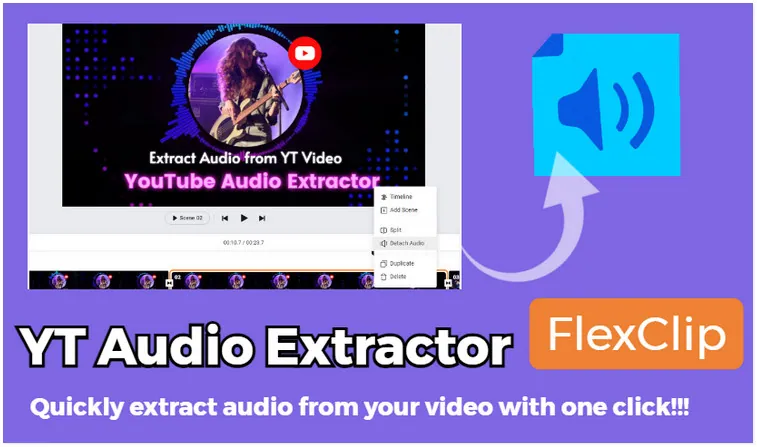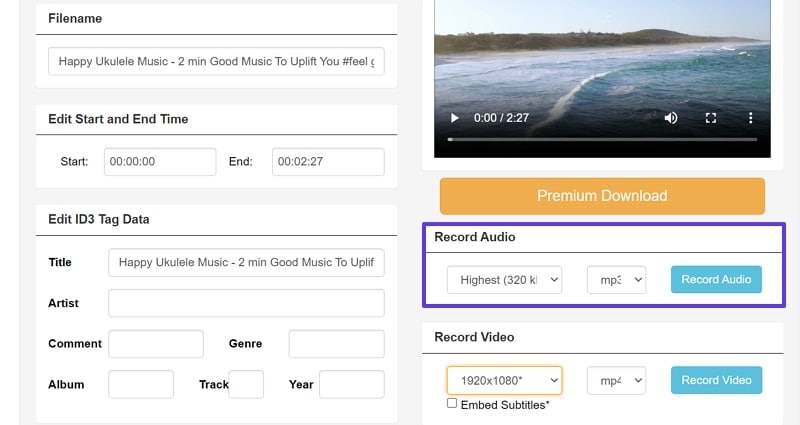Have you ever wanted to snag that perfect audio clip from a YouTube video for your project? Whether it’s a catchy song, an inspiring speech, or background music, extracting audio can be incredibly useful. In this post, we’ll explore various methods to help you do just that, all while staying within legal boundaries. Let’s dive in!
Understanding YouTube’s Terms of Service

Before you start extracting audio from YouTube videos, it's essential to understand YouTube's Terms of Service. Ignoring these terms can lead to copyright issues or even account suspension. Here’s a breakdown of the key points to keep in mind:
- Copyrighted Material: Most content on YouTube is protected by copyright. This means you can't use it without permission unless it falls under fair use.
- Personal Use: If you're extracting audio for personal use, you might have a bit more leeway. However, sharing or distributing that audio can get you into trouble.
- Creative Commons Licenses: Some videos are published under Creative Commons licenses, allowing you to use the audio legally. Always check the video description!
- Commercial Use: If your project is for profit, you must be extra cautious. Using copyrighted audio without permission can lead to DMCA takedown notices.
While it may be tempting to extract audio freely, respecting copyright laws is crucial. It's not just about following rules; it’s about supporting creators. If you love a particular song or speech, consider reaching out to the creator for permission. This not only builds a positive community but also enhances your project with authentic content.
In summary, knowing YouTube’s Terms of Service is vital for anyone looking to extract audio. Make sure to read them thoroughly and stay informed about your rights and responsibilities. This will not only save you potential legal headaches but will also foster a respectful environment for creators.
Also Read This: How to Download YouTube Audio on a Mac: Tools and Techniques
3. Tools for Extracting Audio from YouTube Videos

When it comes to extracting audio from YouTube videos, there’s a wide array of tools available, each with its own unique features. Depending on your needs—whether it’s simplicity, quality, or batch processing—different tools might suit you better. Here’s a rundown of some popular options:
- Online Converters: These are user-friendly and require no installation. Websites like ytmp3.cc and OnlineVideoConverter let you paste a YouTube link and convert it to MP3 with just a few clicks.
- Desktop Software: If you prefer more control and additional features, software like 4K Video Downloader and Any Video Converter are excellent choices. They often allow batch downloads and various audio formats.
- Browser Extensions: For those who want to streamline the process, browser extensions such as Video DownloadHelper can integrate directly into your browser, allowing you to extract audio on the fly while watching videos.
- Mobile Apps: If you’re on the go, apps like TubeMate for Android can help you download audio directly to your phone from YouTube.
Choosing the right tool often comes down to your specific needs and preferences. If you just need a quick conversion, online tools might suffice. However, if you're looking for high-quality audio or need to extract from multiple videos, investing in desktop software might be worthwhile.
Also Read This: How to Download YouTube on Your Smart TV for Seamless Streaming
4. Step-by-Step Guide to Extract Audio

Ready to extract audio from a YouTube video? Follow this simple guide to get your audio files quickly and easily. We’ll cover online converters and desktop software, so you can choose what works best for you.
Using an Online Converter
- Find Your Video: Go to YouTube and navigate to the video you want to extract audio from. Copy the URL from the address bar.
- Open the Converter: Visit a reliable online converter such as ytmp3.cc.
- Paste the URL: In the converter’s field, paste the copied URL and select the audio format (usually MP3).
- Convert: Click the 'Convert' or 'Start' button and wait for the process to complete. This usually takes just a few seconds!
- Download: Once the conversion is done, click the download link to save the audio file to your device.
Using Desktop Software (e.g., 4K Video Downloader)
- Install the Software: Download and install 4K Video Downloader from its official site.
- Copy the Video URL: Just like before, copy the URL of the YouTube video.
- Launch the App: Open 4K Video Downloader and click on the 'Paste Link' button.
- Select Audio Format: After the app processes the link, choose the format (like MP3) and quality for the audio.
- Download: Hit the 'Download' button, and your audio file will be saved to your specified folder.
And there you have it! Whether you’re using an online tool or desktop software, extracting audio from YouTube is straightforward and quick. Now you can enjoy your favorite tracks or incorporate them into your projects hassle-free!
Also Read This: How to Share TikTok Videos on YouTube Without Losing Quality
5. Best Practices for Using Extracted Audio Legally
When diving into the world of extracting audio from YouTube videos, it’s essential to navigate the legal landscape wisely. Here are some best practices to ensure that your use of audio remains ethical and within legal boundaries:
- Understand Copyright: Most YouTube videos are protected by copyright, meaning you typically can’t use the audio without permission. Familiarize yourself with copyright laws in your country. In many places, using audio without permission could lead to legal repercussions.
- Seek Permission: If you find a track you love, consider reaching out to the creator. Many YouTubers are open to collaboration or may grant permission for specific uses. Just be sure to get any agreement in writing for your records.
- Use Creative Commons Licensed Audio: Some creators publish their videos under Creative Commons licenses, allowing for certain uses without permission. Always check the license type and adhere to its terms. For example, some may require attribution.
- Credit the Creator: When using extracted audio, giving credit is a great way to show respect to the creator. This can be as simple as mentioning their name and the original video in your project's credits.
- Limit the Use: If you do use copyrighted audio, consider using short snippets instead of full tracks. Fair Use may apply in some cases, particularly for educational, transformative, or critique purposes, but it’s always a gray area.
By adhering to these best practices, you can enjoy the rich world of audio while respecting the rights of creators and minimizing the risk of legal issues. Remember, a little respect goes a long way in the creative community!
6. Alternative Sources for Audio for Your Projects
If you’re looking for audio to enhance your projects without the legal headaches, there are plenty of alternative sources that provide high-quality audio for free or at a low cost. Here are some great options:
- Free Music Archive: This site offers a vast collection of music across various genres, all available for free. Just check the licensing terms for each track to ensure it fits your project's needs.
- Incompetech: Created by composer Kevin MacLeod, this site features a wide range of royalty-free music. Simply give credit as specified, and you can use the tracks in your projects without any cost.
- SoundCloud: Many artists on SoundCloud allow downloads of their tracks for free. Look for tracks labeled with Creative Commons licenses for legal use.
- AudioJungle: If you’re willing to spend a little money, AudioJungle offers a vast selection of royalty-free music. Prices vary, but the quality is often well worth it.
- YouTube Audio Library: This is a treasure trove of free music and sound effects provided directly by YouTube. You can use them in your videos without worrying about copyright claims, as long as you follow their guidelines.
Exploring these sources can save you time and ensure that your projects have the perfect audio backdrop without any legal complications. So dive in, explore, and let your creativity flow!
 admin
admin








